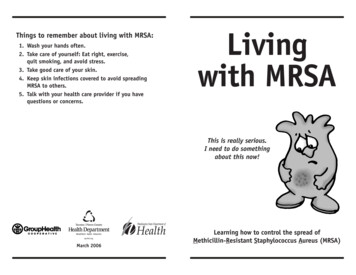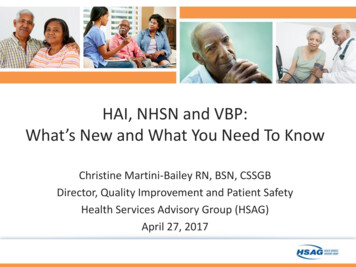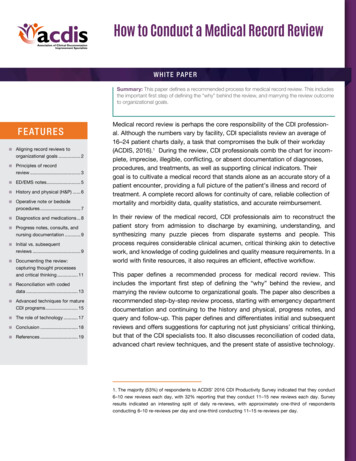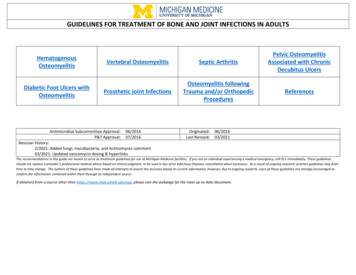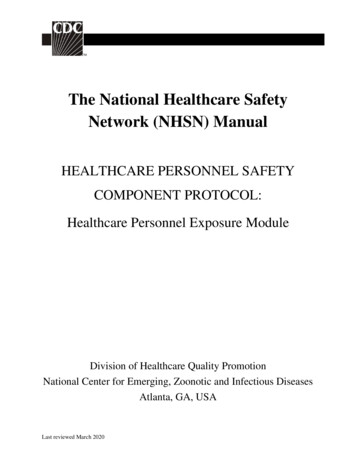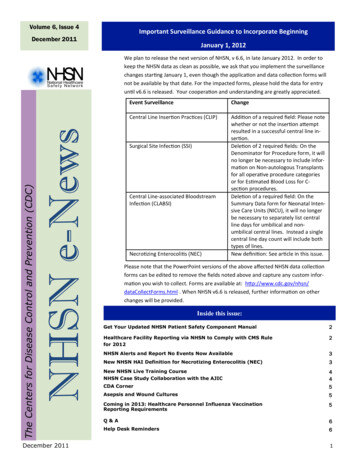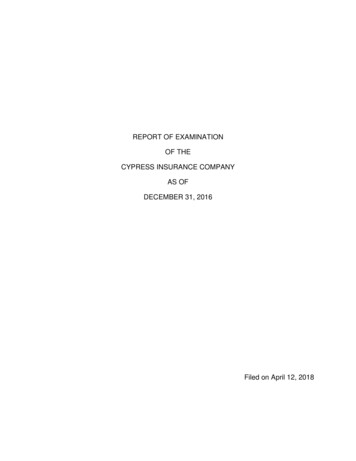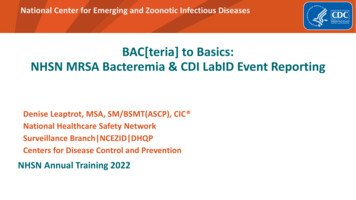
Transcription
National Center for Emerging and Zoonotic Infectious DiseasesBAC[teria] to Basics:NHSN MRSA Bacteremia & CDI LabID Event ReportingDenise Leaptrot, MSA, SM/BSMT(ASCP), CIC National Healthcare Safety NetworkSurveillance Branch NCEZID DHQPCenters for Disease Control and PreventionNHSN Annual Training 2022
OBJECTIVES Understand and apply LabID event reporting concepts asoutlined in the NHSN PSC MDRO Chapter 12 Recognize MRSA bacteremia and C. difficile events using NHSNdefinitions to provide events for reporting Correctly Report LabID Events and FacWideIN summarydenominator data
html
Key Concepts to LabID Event Reporting: FacWideIN LabID event reporting is based on patient and location.All inpatient units and ED/24-hour observation locations areincluded. The first positive specimen for the location meetingdefinition is submitted as a LabID event. NHSN does NOT use patient ‘status’ for reporting. An ‘inpatient’ is apatient housed on an inpatient location. An ‘outpatient’ is a patienthoused on an outpatient unit such as the ED or a dedicated 24-hourobservation unit. Facility specific status designations such as‘observation’, ‘inpatient’, ‘outpatient’, ‘swing bed patient’ or ‘shortstay patient’ are not used for in NHSN reporting.
For NHSN reporting purposes, the ‘date admitted to facility’ is thecalendar day the patient locates to an inpatient location. Time spent inthe ED or on a dedicated 24-hour observation unit is outpatient hours. LabID event reporting includes a ‘14-day’ rule which prohibits a ‘new’LabID event to be submitted for the patient in the SAME location until 15days has passed between positive specimens. This rule is locationspecific and resets each time the patient moves to a ‘new’ location.
LabID Event reporting is based strictly on laboratory testing datawithout clinical evaluation of the patient, allowing for a much lesslabor intensive method to track C. difficile and MDROs, such as MRSA.Symptoms are NOT used in LabID event reporting. No clinicaldetermination is included in LabID event reporting. These provide proxy infection measures of healthcare acquisition,exposure burden, and infection burden are based primarily onlaboratory and limited admission data.
LabID Event reporting is by single facility; prior positivesidentified at a different facility will not influence reporting atyour facility and are not considered in event categorization. ***the ‘Transfer Rule’ does NOT apply to LabID eventreporting LabID Events are attributable to the location where thepositive specimen is collected. There is no timerequirement for ‘how long’ the patient must be housed onthe unit to be eligible for reporting.
CHECKLIST:Facility-wide {FacWideIN} LabID Event Reporting Review location options and map locations in NHSN as necessary. Review Monthly Reporting Plan(s) and update as necessary. Identify and enter all LabID events into NHSN by location. Enter denominator data for each month under surveillance. Resolve “Alerts”, if applicable.
FacWideIN requires mapping of bedded inpatient locations forthe facility, all EDs and dedicated 24-hour Observation units
Find 15locationsdescriptions current.pdf
CHECKLIST: FacWideIN LabID Event Reporting Review location options and map locations in NHSN as necessary. Review Monthly Reporting Plan(s) and update as necessary. Identify and enter all C. difficile LabID events into NHSN by location. Enter denominator data for each month under surveillance. Resolve “Alerts”, if applicable.
Monthly Reporting Plan The Monthly Reporting Plan informs CDC which modules a facility isparticipating in during a given month. Referred to as “In-Plan” data A facility must enter a Plan for every month of the year. Add facility-wide inpatient reporting for MRSA Bacteremia and C. difficileLabID events to your monthly reporting plan (MRP) using the“FACWIDEIN” location. Emergency departments and 24-hour observation locations are includedin FacWideIN reporting. NOTE** These locations will ‘automatically’ beadded to your monthly reporting plan when you select ‘FacWideIN’ aslong as you do NOT use the ‘copy from previous month’ option whenselecting the monthly reporting plan.
Creating a Monthly Reporting Plan
Creating a Monthly Reporting Plan
CHECKLIST: FacWideIN LabID Event Reporting Review location options and map locations in NHSN as necessary. Review Monthly Reporting Plan(s) and update as necessary. Identify and enter all LabID events into NHSN by location. Enter denominator data for each month under surveillance. Resolve “Alerts”, if applicable.
Protocol Standard Guidance Events are reported by patient AND location. Each locationchange for the patient resets reporting. The first lab positive finding for the patient in a locationqualifies as a LabID event. Following this submission, noadditional LabID events are submitted into NHSN for thelocation until there is a 14-day gap in positive findings. LabID Events are attributable to the location where thepositive specimen is collected.
Definition: C. difficile LabID Event C. Difficile-positive laboratory assay**excludes locationsknown to predominately house babies (NICU, Nursery, etc.)A positive laboratory test result for C. difficiletoxin A and/or B, (includes molecular assays[PCR] and/or toxin assays) tested on an unformedstool specimen (must conform to the container).A toxin-producing C. difficile organism detected byculture or other laboratory means performed on anunformed stool sample (must conform to thecontainer).NOTE** When using a multi-step testing algorithm for CDIon the same unformed stool specimen, the finding of thelast test performed on the specimen that is documented inthe patient medical record will determine if the CDIpositive laboratory assay definition is met.
Event - Patient Information
Event Information- Specimens Collected from:Outpatient LocationInpatient Location
NHSN will Categorize C. difficile LabID Events Based onLocation & Specimen Collection Date: Community-Onset (CO): LabID Event meeting one of the following criteria:A) collected in an outpatient location in which the patient was not previously discharged from an inpatient locationwithin the same facility less than or equal to 28 days prior to current date of specimen collection - B) collected in aninpatient location on HD 1 [day of admission], HD 2 or HD 3. Community-Onset Healthcare Facility-Associated (CO-HCFA): CO LabID Event collected from an inpatient or anoutpatient location from a patient who was discharged from the facility less than or equal to 28 days prior to currentdate of stool specimen collection. The previous discharge must have been from an inpatient location within the samefacility (in other words, an outpatient visit does not qualify as “admitted”, and therefore is not used to set the timelinefor CO-HCFA). Healthcare Facility-Onset (HO): LabID Event collected from an inpatient location on or after HD 4 where HD 1 is dayof admission.
NHSN will Categorize C. difficile LabID Events Based onLocation & Specimen Collection Date:CDI LabID Events are further categorized by NHSN as Incident orRecurrent. Refer to the ‘cdiAssay’ variable in the NHSN Line List. Incident CDI LabID Event: Any CDI LabID Event from a specimen obtained more than56 days after the most recent CDI LabID Event (or with no previous CDI LabID Eventdocumented) for that patient. Note: the date of first specimen collection isconsidered day 1.Recurrent CDI LabID Event: Any CDI LabID Event from a specimen obtained morethan 14 days and less than or equal to 56 days after the most recent CDI LabID Eventfor that patient. Note: the date of first specimen collection is considered day 1.CdiAssay will be unassigned, or “blank”, for any CDI LabID event collected less thanor equal to 14 days after the most recent CDI LabID event for that patient.
Let’s Review C. difficile LabID Event Reporting For FacWideIN, C. difficile toxin-positive specimens MUST be monitoredfor all inpatient locations within a facility (includes ED and 24-hour OBSlocations) but not for predominately baby locations {Nursery, NICU, etal}. All LabID Event(s) MUST be entered without regard to date of occurrence.Community-Onset (CO) or Healthcare facility-onset (HO). Only unformed stools should be tested for C. difficile. Internal ‘rejection’policies should be used to ensure appropriate testing. A positive CD finding from unformed stool specimen qualifies as a LabIDEvent if there has not been a previous positive laboratory result for thepatient in the location within the previous 14 days.
Definition: MRSA bacteremia LabID EventMRSA identified from blood culture: Includes S. aureus cultured from a blood culture specimen that tests oxacillinresistant, cefoxitin resistant, or methicillin-resistant by standard susceptibilitytesting methods, ORAny lab finding where MRSA is specifically identified (includes but not limitedto PCR or other molecular based detection methods).NOTE** Applies to ALL inpatient locations [including locations known topredominately house babies] and Emergency Departments and 24-hourObservation locations.
Event Information- Specimens Collected from:Outpatient LocationInpatient Location
NHSN will Categorize MRSAbacteremia LabID Events Basedon Location & SpecimenCollection Dates
Let’s Review MRSA bacteremia LabID Event Reporting For FacWideIN, MRSA blood cultures are monitored for all inpatientlocations within a facility , including ED and 24-hour OBS locations as wellas predominately baby locations {Nursery, NICU, etal.}. All LabID Event(s) MUST be entered without regard to date of occurrence.Community-Onset (CO) or Healthcare facility-onset (HO). The first MRSA BC for the patient and the location qualifies as a LabIDevent. No additional MRSA LabID events are submitted for the patient inthe location until there has been 14 days from prior MRSA BC. This is a‘rolling’ 14-day timeframe not specifically based on a previously submittedMRSA LabID event(s). Each location change resets reporting.
CHECKLIST:FacWideIN LabID Event Reporting Review location options and map locations within NHSN as necessary. Review Monthly Reporting Plan(s) and update as necessary. Identify and enter all LabID events into NHSN by location. Enter denominator data for each month under surveillance. Resolve “Alerts”, if applicable.
Entering Denominator Data in NHSN Application Click on ‘Summary Data’ and then ‘Add’ on the left-hand navigation bar. Select ‘MDRO and CDI Monthly Denominator –All Locations’ from theSummary Data Type dropdown menu (see screenshot). This is a differentform than the one you use to report summary data for CLABSI and CAUTI.
DenominatorData: FacWideIN On the summary dataentry screen, selectFACWIDEIN as the locationfor which you are enteringthe summary data. Afterselecting the FACWIDEINlocation, month, and year,six summary data fieldswill become required.
DenominatorData Select CDI Test type quarterly(last month of each calendar-yearquarter – March; June;September; December) OTHER -. ‘Other’ should not beused to name specificlaboratories, referencelaboratories, or the brand namesof C. difficile tests; most methodscan be categorized accurately byselecting from the optionsprovided
Denominator Data: Inpatient Rehab or Inpatient Psych units On the summary data entry screen, use the ‘Location Code” drop down menu to select the Rehabor Psych unit included as separate row on your monthly reporting plan {in addition to FacWideIN}. After selecting the appropriate unit, month, and year, complete 2 required fields
Denominator Data: Emergency Department / 24-hour observation On the summary data entry screen, use the ‘Location Code” drop down menu to select ED or 24hour observation as the location for which you are entering the summary data. After selecting the appropriate unit, month, and year, one summary data field will become required(Total Encounters). Repeat steps for 24-hour observation locations. 1 visit 1 encounter
CHECKLIST:FacWideIN LabID Event Reporting Review location options and map locations in NHSN as necessary. Review Monthly Reporting Plan(s) and update as necessary. Identify and enter all C. difficile LabID events into NHSN by location. Enter denominator data for each month under surveillance. Resolve “Alerts”, if applicable.
Denominator Data: Report No Events If you have reported any LabID events during the month, you are finished with yourreporting for the month and can skip this step. If you have no LabID events for the specific month of reporting, you must indicate this onthe summary data record to complete your reporting efforts. On the MDRO and CDI Module summary data form, checkboxes for “Report No Events”are found underneath the patient day and admission count fields, as seen in thescreenshot below.If no LabID events are submitted forthe month, these boxes should be“checked” for each event you arefollowing “in-plan”. If these boxesare not checked, your data is notcomplete and will not be submittedto CMS.If you identify and enter LabID events for an organism after you’ve already checked the “Report No Events” box, the “Report No Events”check will automatically be removed in the NHSN database.
LabID Event or/index.html Available for use with C. difficile and MRSA LabID Event reporting Aids in decision making around the 14-day rule External calculator
National Center for Emerging and Zoonotic Infectious DiseasesLinks to Analysis: SIR Guide, to learn more about the SIR & how it’s calculated [updated sources/nhsn-sir-guide.pdf Introduction to NHSN 19/intro-nhsn-analysis-508.pdf. Analyzing LabID Event Data in abid-update-508.pdf
Checkpoint – learning assessment: 65yo patient undergoing treatment for lymphoma presents to the ED fromhome unresponsive with significant low BP. Fluid resuscitation initiatedwith blood cultures/labs collected. After stabilization, the patient isadmitted to ICU on 2/1 The patient’s standard chemotherapy infusion isconducted on 2/3 and TPN/lipids are started. Later this day, blood culturesare collected after temp spike. The 2/1 and 2/3 blood cultures result asMRSA on 2/4. Diarrhea is noted first on 2/4 continuing 2/5 and 2/6. Anunformed stool specimen is collected 2/6, testing positive for C. difficile. Thepatient has a sudden cardiac arrest and expires 2/7. If you’re monitoring FacWideIN MRSA bacteremia and C. difficile LabIDevents, are there events for reporting and if so, how many?
Answers to learning exercise LabID events:(1) 2/1 MRSA LabID event for ED(2) 2/3 MRSA LabID event for ICU(3) 2/6 CD LabID event for ICUBONUS: How are these events categorized?2/1 ED event is CO as it occurs in an outpatient location2/3 event is CO as the event occurs on HD 3 [day of admit HD 2/1, 2/3]2/6 event is HO as the event occurs on HD 6
Questions ?contact the NHSN Helpdesk at nhsn@cdc.govThe material provided is based on NHSN Patient Safety Component protocols and do not necessarily represent the official position of the Centers for Disease Control and Prevention.
BAC[teria] to Basics: NHSN MRSA Bacteremia & CDI LabID Event Reporting Denise Leaptrot, MSA, SM/BSMT(ASCP), CIC National Healthcare Safety Network . Surveillance Branch NCEZID DHQP. Centers for Disease Control and Prevention. NHSN Annual Training 2022
